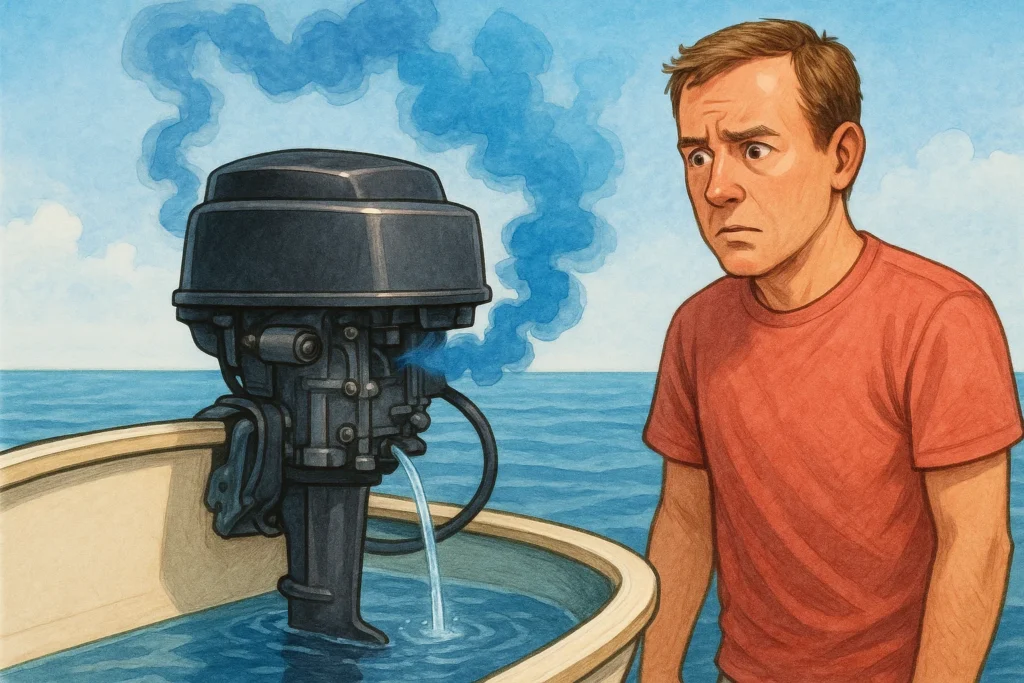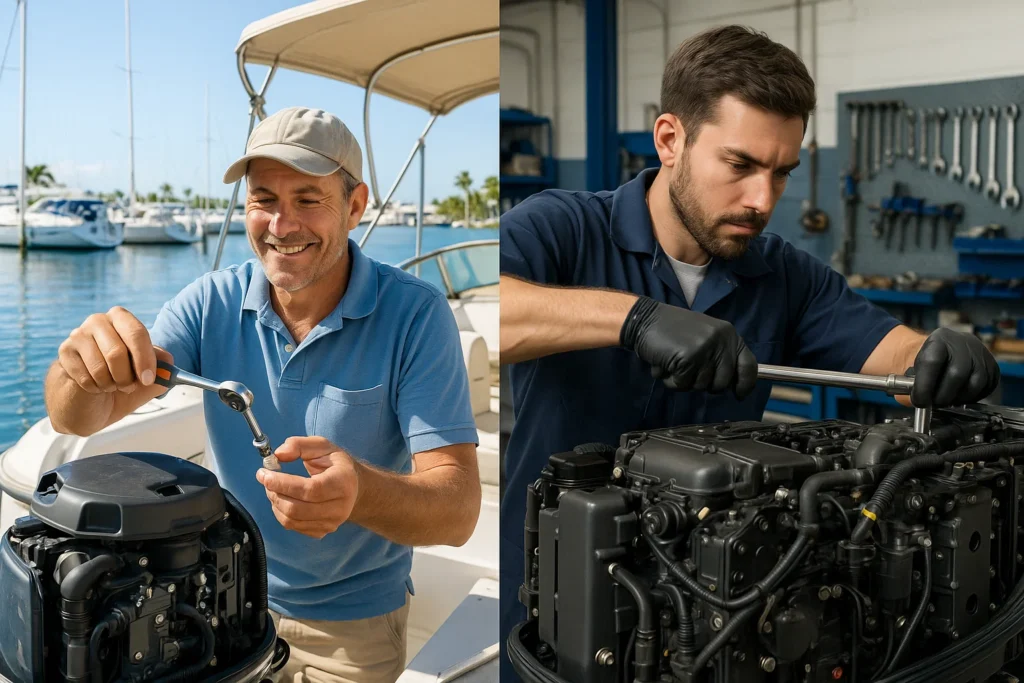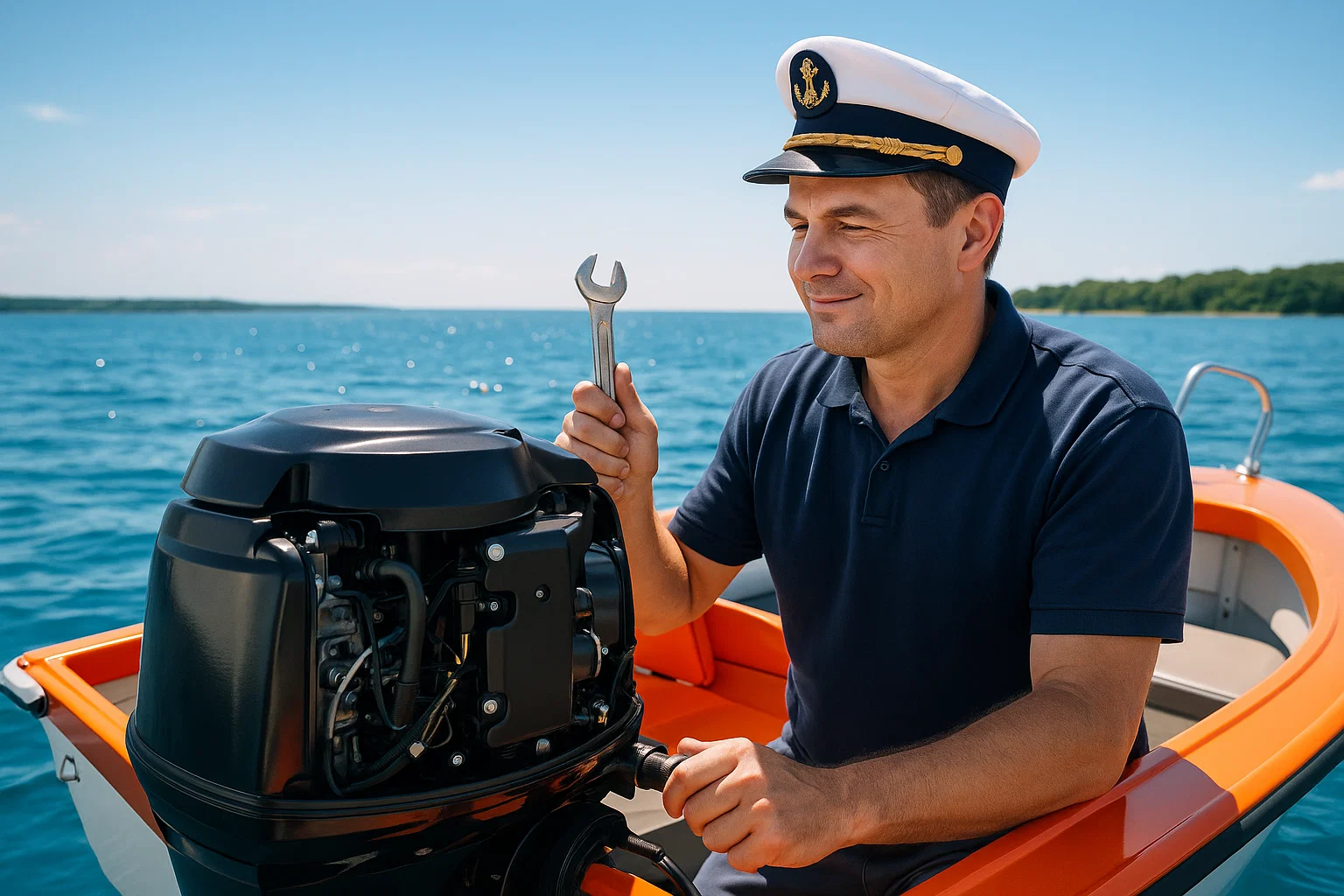Key Takeaways
Don’t let engine trouble ruin your day on the water. Understanding your engine’s needs, from diagnosing common problems to knowing when to call a pro, is the key to confident and reliable boating. Here are the essential insights to keep you running smoothly all season long.
- Decode distress signals before they become disasters; a weak “tell-tale” stream often means a simple blockage or worn impeller, while smoke color can pinpoint if you’re burning oil (blue) or water (white).
- Know your limits when deciding between DIY and a pro. While you can easily change spark plugs and oil, persistent overheating or internal engine noises always require a professional technician.
- Vet mechanics thoroughly by asking for their labor rate, certifications, and proof of insurance. A refusal to provide a clear, written estimate before work begins is a major red flag.
- Insist on a professional repair process that includes a signed work order based on a detailed estimate. The most critical final step is a post-repair sea trial to verify the fix under a real-world load.
- Proactive maintenance is your best defense against costly breakdowns. Following a simple seasonal checklist is the single best way to extend your engine’s life and ensure reliability.
- Assemble an on-board “save-a-trip” kit with essential spares like a fuel filter, spark plugs, and an impeller. This is the cheapest insurance you can buy to handle the most common on-water issues yourself.
Dive into the full guide below to become a more confident and prepared boat owner, ready to handle anything the season throws your way.
Introduction
There’s no sound more frustrating to a boat owner than silence when you turn the key.
That sudden quiet, miles from the dock, can turn a perfect day on the water into a stressful ordeal. But whether it’s a sputtering engine, a strange noise, or a complete failure to start, engine trouble doesn’t have to ruin your season.
Knowing how to respond is the difference between a minor inconvenience and a major, costly repair.
This guide is your complete roadmap for handling any small marine engine issue with confidence. We’ll walk you through everything from initial diagnosis to finding the right expert help.
You’ll learn how to:
- Quickly decode your engine’s most common distress signals.
- Confidently decide between a DIY fix and calling a professional.
- Find and vet a trustworthy local marine mechanic.
- Prevent future problems with a simple maintenance routine.
It all begins with learning to listen. Understanding what your engine is trying to tell you is the first and most critical step toward a fast, reliable solution.
Decoding Your Engine’s Distress Signals: Common Small Marine Engine Problems
Your marine engine is constantly communicating. Learning its language helps you catch small issues before they sideline your day on the water.
Understanding these distress signals empowers you to have a more informed conversation with a mechanic or even tackle a simple fix yourself.
The All-Too-Common “No Start”
There’s nothing more frustrating than an engine that won’t turn over or fires up weakly. Before you panic, start with the simplest checks first. The culprit is often one of two things:
- Battery & Electrical: Check that your battery is charged and the terminals are clean and tight. A simple click often points to a battery or connection issue, not a major engine failure.
- Fuel System Blockage: Is the tank empty? Is the fuel line’s primer bulb firm? A clogged fuel filter or vent can starve the engine, preventing it from starting.
Overheating and Power Loss
An engine that’s running hot or feels sluggish is sending a clear warning. An overheating alarm requires immediate shutdown to prevent catastrophic damage.
If your boat feels slow or the engine sputters, investigate these common causes:
- Cooling System Issues: Check the “tell-tale” stream. A weak or nonexistent stream of water means you likely have a blockage in the raw water intake or a worn-out impeller.
- Fuel Delivery Problems: Old, unstabilized fuel and clogged fuel filters are frequent causes of rough performance and power loss.
- Fouling: Don’t forget to look under the boat! Marine growth on the hull or a damaged propeller can make your engine work harder, mimicking internal problems.
Alarming Sounds and Smoke Signals
Unusual noises and smoke are direct messages about your engine’s health. Learning to read them is a critical skill for any boat owner.
Pay close attention to these signals:
- Blue Smoke: You’re likely burning oil, which could indicate worn piston rings or other internal issues.
- Black Smoke: The engine is running “rich,” meaning there’s too much fuel in the mix, often due to a carburetor or injector problem.
- White Smoke/Steam: While a little steam at startup can be normal condensation, excessive white smoke can be a serious sign of water entering the combustion chamber.
By learning to recognize these key symptoms, you can quickly diagnose most common engine troubles, ensuring you spend less time troubleshooting and more time enjoying the water.

The Critical Decision: DIY Repair vs. Calling a Professional
Deciding whether to tackle a boat engine issue yourself or call a professional is a critical choice. The right decision saves you time and money, while the wrong one can lead to a ruined weekend and a much bigger repair bill.
It all comes down to an honest self-assessment of the job’s complexity, your personal skill level, and the tools you have on hand.
Assessing the Job’s Complexity
Not all repairs are created equal. Some are simple maintenance, while others require specialized knowledge and tools to avoid causing further harm.
Here’s a practical breakdown to help you decide:
- Beginner-Friendly DIY Tasks: These are jobs most owners can handle with a basic toolkit and a good manual.
- Changing spark plugs and engine oil
- Replacing an easy-to-access fuel filter
- Cleaning battery terminals and checking connections
- Inspecting the propeller for dings or fouling
- Intermediate Repairs (Proceed with Caution): These tasks require more mechanical confidence and a greater risk if done incorrectly.
- Replacing a water pump impeller or thermostat
- Troubleshooting fuel lines for air leaks
- Rebuilding a carburetor (only for experienced DIYers)
- When to ALWAYS Call a Pro: Don’t hesitate to call for help with these issues. The risk of causing catastrophic damage is too high.
- Any internal engine work (e.g., pistons, bearings)
- Persistent overheating after you’ve checked for simple blockages
- Complex electrical diagnostics
- Significant noises like knocking, grinding, or heavy vibration
Evaluating Your Skills, Tools, and Time
Before you break out the wrenches, ask yourself a few key questions. Do you have the right marine-grade tools? A weekend spent trying to save $150 on labor can easily cost you $1,000 in new parts if the repair goes wrong.
Factor in the cost of your time. If a professional can fix it in two hours, but it will take you all of Saturday, is the savings worth losing a day on the water?
Knowing your limits is the most important tool in any boat owner’s kit. A smart decision upfront ensures you spend more time enjoying your boat and less time fixing it.
Finding and Vetting a Reliable Marine Mechanic Near You
When your engine needs more than a simple DIY fix, finding the right professional is critical. The challenge isn’t just finding a mechanic—it’s finding a skilled and trustworthy one.
Here’s a simple guide to locating a reliable expert who will get you back on the water without the hassle.
Where to Start Your Search
Cast a wide net by tapping into both digital and real-world networks. Your goal is to build a short list of qualified candidates.
Start by exploring these proven sources:
- Local Marinas and Boat Yards: These are often the best places to find trusted, on-site mechanics with a solid reputation.
- Online Reviews and Forums: Use Google Maps and marine-specific forums to see what other boaters are saying.
- Word-of-Mouth: Ask fellow boaters at your dock or club for their go-to recommendations. A personal referral is often the most reliable lead.
- Manufacturer-Certified Technicians: If you have a specific engine brand like Mercury or Yamaha, look for a specialist certified to work on it.
Key Questions to Ask Before You Hire
Don’t be afraid to interview a potential mechanic before committing. Their answers will tell you everything you need to know about their professionalism and expertise.
Make sure you ask about:
- Experience and Specialization: “How long have you worked on marine engines?” and “Do you specialize in my engine’s make and model?”
- Logistics and Pricing: “What’s your hourly labor rate?” and “Do you provide written estimates before starting work?”
- Certifications and Insurance: “Are you certified by an organization like the ABYC?” and “Can you provide proof of liability insurance?”
- Warranty: “What kind of warranty do you offer on parts and labor?”
Red Flags to Watch Out For
Knowing what to avoid is just as important as knowing what to look for. Trust your gut—if something feels off, it probably is.
Be cautious of any mechanic who:
- Gives vague estimates or shows a refusal to provide a written quote.
- Hesitates to show you their certifications or proof of insurance.
- Uses high-pressure sales tactics or demands full payment upfront.
- Works out of a messy, disorganized shop—it can be a sign of their work quality.
Taking the time to properly vet a marine mechanic is the single best investment you can make in your boat’s reliability. A little homework now prevents major headaches and costly surprises down the line.

The Professional Repair Process: What to Expect
Handing over your engine keys can be stressful. Knowing what a professional repair process looks like helps you stay in control and ensures you get quality work.
A trustworthy mechanic follows a clear, transparent procedure from start to finish.
Step 1: The Initial Diagnosis and Estimate
The process begins with a systematic diagnosis, not guesswork. A skilled technician will methodically troubleshoot to pinpoint the exact problem.
Once they identify the issue, you should receive a detailed written estimate. This document is your roadmap for the repair and should clearly outline:
- Parts Costs: The price for each component needed.
- Labor Rate: The shop’s hourly charge and the estimated time for the job.
- Shop Fees: Any additional charges for supplies or environmental disposal.
Never proceed without a signed work order. This document protects both you and the mechanic by creating a clear agreement on the work to be done.
Step 2: The Repair Itself
Once you authorize the work, the mechanic gets started. A key part of a quality repair is the choice of parts. Many professional shops prefer using Original Equipment Manufacturer (OEM) parts to ensure perfect fit and performance, just like the factory intended.
A great shop keeps you in the loop. You should expect a call if they discover any unexpected issues that could affect the cost or timeline. Turnaround times can vary based on:
- The complexity of the repair.
- Current shop workload.
- Availability of specific parts.
Step 3: Job Completion and Sea Trial
The job isn’t done when the last bolt is tightened. Before you pay, carefully review the final invoice and compare it to the initial estimate. Ask for a clear explanation of any differences.
The most critical final step is the post-repair sea trial. This means running the engine on the water, under a real-world load, to verify the problem is truly solved. Finally, get the warranty details in writing so you know exactly what is covered and for how long.
A professional repair process is built on clear communication, written documentation, and a final test that proves the work was successful. This ensures you leave the shop with confidence, ready to get back on the water without worry.
Proactive Maintenance: Your Best Defense Against Costly Repairs
The most reliable engine isn’t the newest or most expensive—it’s the one that’s consistently cared for. The absolute best defense against costly repairs is establishing a simple, proactive maintenance routine.
An hour of prevention on the dock is worth an entire weekend of frustration on the water. This habit not only extends your engine’s life but ensures it’s ready to go when you are.
Creating Your Annual Maintenance Checklist
A structured, seasonal approach makes engine care manageable and easy to remember. Think of it as a simple to-do list for a hassle-free boating season.
- Pre-Season (Spring Commissioning): This is your most important tune-up.
- Change the engine oil and filter.
- Replace fuel filters to prevent sputtering and power loss.
- Inspect all belts and hoses for cracks or wear.
- Check and replace spark plugs and sacrificial anodes.
- Fully charge and test your battery and connections.
- In-Season Checks: Perform these quick checks before or after each trip.
- Visually inspect fluid levels (oil, coolant).
- Clean the raw water strainer to ensure proper cooling.
- Post-Season (Winterization): Protect your engine from off-season damage.
- Flush the cooling system completely.
- Use a fuel stabilizer to prevent buildup and water contamination.
- “Fog” the engine’s internal components to prevent rust.
The On-Board “Save-a-Trip” Kit
Picture this: you’re miles from shore and the engine dies. Instead of a costly tow, a 15-minute fix gets you home. That’s the power of a well-stocked on-board emergency kit.
It’s the cheapest insurance policy you can buy.
- Essential Spares: Keep these critical parts on board at all times.
- Spare fuel filter (the #1 cause of sudden engine trouble)
- Extra spark plugs
- A new water pump impeller
- Spare belts and hoses that fit your engine
- Essential Tools & Supplies:
- A quality marine-grade toolset with wrenches and screwdrivers
- Zip ties, electrical tape, and spare hose clamps
- A water-dispersing spray like WD-40
Treating maintenance as a non-negotiable part of boating transforms your experience from reactive and stressful to confident and reliable. A simple checklist and a small tool kit are your keys to a perfect day on the water.
Conclusion
Your engine’s reliability isn’t a matter of luck; it’s a direct result of your confidence and preparation. By understanding its language and knowing when to act, you shift from being a passenger to being the captain of your vessel’s health.
This knowledge transforms engine care from a stressful chore into the very foundation of great days on the water.
Here are the key actions that will keep you running smoothly:
- Listen to your engine: Learn to recognize the early warnings—unusual sounds, smoke, or power loss—to catch issues before they escalate.
- Know your limits: Honestly assess if a job is a simple DIY fix or requires a professional. A smart call here is your best tool.
- Vet your mechanic: Never skip the crucial step of asking for written estimates, checking certifications, and getting referrals.
- Embrace proactive maintenance: A simple seasonal checklist is the single best investment you can make in your boat’s reliability and your own peace of mind.
Your immediate next step is simple. Take 15 minutes this week to build your on-board emergency kit with a spare fuel filter and basic tools. It’s the cheapest insurance you can buy for a perfect day on the water.
Ultimately, a well-maintained engine does more than just power your boat—it powers your confidence. Treat it well, and it will always bring you home.


Leave a Reply